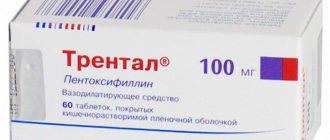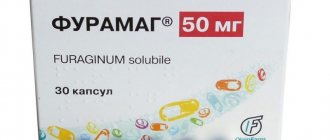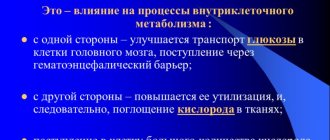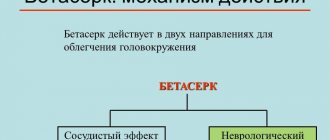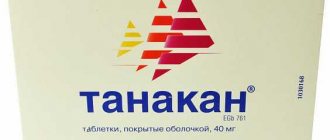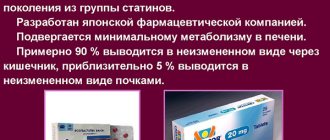Trental is a peripheral vasodilator. The medication is produced in solution for injections and in tablets based on the active ingredient - pentoxifylline. There are many structural analogues of Trental based on pentoxifylline on the pharmacological market.
Trental is used to treat the following disorders:
- encephalopathy of atherosclerotic origin;
- ischemic stroke;
- disruption of blood flow in peripheral arteries due to the development of systemic atherosclerosis;
- diabetic type angiopathy;
- ulcers of diabetic or atherosclerotic etiology;
- gangrene;
- Raynaud's syndrome
- varicose veins;
- improper blood flow in the eyes, which can cause inflammation of the optic nerve and organ failure;
- ear diseases.
Trental is not prescribed for the following reasons:
- allergy to the composition;
- excessive bleeding and predisposition to it;
- hemorrhagic stroke and hemorrhage in the eye;
- acute phase of myocardial infarction;
- ulcerative destruction in the digestive tract;
- hemorrhages.
The medicine is also not prescribed to pregnant women and during lactation. Adverse reactions from the use of Trental:
- neurological disorders - dizziness and pain in the head, irritability and anxiety, convulsions and tremors of the arms and legs, hallucinations and paresthesia, disturbance of sleep rhythm;
- dermatological reactions - urticaria and hyperemia of the epidermis, flushing of the face, swelling and fragility of the nail plate;
- reactions of the digestive tract - diarrhea, nausea and vomiting, cholecystitis, hepatitis;
- cardiac disorders - tachycardia and blood pressure fluctuations, edema in the periphery, arrhythmia and angina.
Composition and release form
Trental® Enteric film-coated tablets - 1 tablet. pentoxifylline - 100 mg excipients: lactose; starch; talc; colloidal silicon dioxide; magnesium stearate shell: methacrylic acid copolymer; sodium hydroxide; macrogol (polyethylene glycol) 8000, talc; titanium dioxide (E171) in a blister 10 pcs; There are 6 blisters in a cardboard pack. Concentrate for the preparation of solution for infusion - 1 ml pentoxifylline - 20 mg excipients: sodium chloride; water for injection in ampoules of 5 ml; There are 5 ampoules in a cardboard pack. Trental® 400 Extended-release film-coated tablets - 1 tablet. pentoxifylline - 400 mg excipients: povidone (PVP); hyaetellose (hydroxyethylcellulose); talc; magnesium stearate shell composition: hypromellose (hydroxypropyl methylcellulose); benzyl alcohol; titanium dioxide; talc; macrogol (polyethylene glycol) 6000; 10 pcs in blister; There are 2 blisters in a cardboard pack.
Trental or Mexidol - which is better for blood vessels
Mexidol is an original domestic drug in ampoules and tablets. Belongs to the group of antioxidant agents. Improves cerebral metabolism, blood supply to the brain, reduces platelet adhesion to the walls of blood vessels, reduces cholesterol levels, increases the body's resistance to stress factors (oxygen starvation, exposure to alcohol, ischemia, shock, etc.).
Trental is prescribed to improve cerebral and peripheral blood supply and prevent platelet aggregation.
Which is better – Trental or Mexidol – is determined individually. Medicines have common characteristics, however, they belong to different pharmacological groups and have different effects.
The choice of a Trental substitute must be agreed with your doctor by filling out a special prescription form. Before purchasing, it is advisable to read the instructions for use and ask a specialist any questions you may have.
pharmachologic effect
Trental is a drug with a blood-thinning effect, which is used to improve blood circulation in atherosclerosis and diabetes mellitus
Pharmacokinetics
Tablets 100, 400 mg After oral administration, pentoxifylline is quickly and almost completely absorbed. After almost complete absorption, pentoxifylline is metabolized. The absolute bioavailability of the original substance is (19±13)%. The main active metabolite 1-(5-hydroxyhexyl)-3,7-dimethylxanthine (metabolite-1) has a plasma concentration that is 2 times higher than the initial concentration of pentoxifylline. T1/2 of pentoxifylline after oral administration is 1.6 hours. Pentoxifylline is completely metabolized, more than 90% is excreted through the kidneys in the form of unconjugated water-soluble metabolites. The elimination of metabolites is delayed in patients with impaired renal function. In patients with impaired liver function, T1/2 of pentoxifylline is prolonged and absolute bioavailability increases.
Solution for infusion Pentoxifylline is extensively metabolized in red blood cells and the liver. Among the most well-known metabolites, metabolite-1 (M-1; hydroxypentoxifylline) is formed due to cleavage, and metabolite-4 (M-IV) and metabolite-5 (MV; carboxypentoxifylline) are formed due to oxidation of the main substance. M-l has the same pharmacological activity as pentoxifylline. More than 90% of the taken dose of pentoxifylline is excreted through the kidneys and 3-4% in the feces. T1/2 of pentoxifylline after intravenous administration of 100 mg was approximately 1.1 hours. In patients with severe liver dysfunction, T1/2 of pentoxifylline increases. Pentoxifylline has a large volume of distribution (168 L after 30 minutes of infusion of 200 mg) and a high clearance of approximately 4500-5100 ml/min. Pentoxifylline and its metabolites do not bind to plasma proteins. In severe renal impairment, the elimination of metabolites is slowed down.
Pharmacodynamics
Trental® improves the rheological properties of blood (fluidity) by affecting the pathologically altered deformability of red blood cells, inhibiting platelet aggregation and reducing high blood viscosity. Trental® improves microcirculation in areas of poor circulation. As an active ingredient, Trental® contains a xanthine derivative - pentoxifylline. The mechanism of its action is associated with the inhibition of phosphodiesterase and the accumulation of cAMP in the cells of vascular smooth muscles and blood cells. Providing a weak myotropic vasodilator effect, pentoxifylline slightly reduces peripheral vascular resistance and slightly dilates the coronary vessels. Treatment with Trental® leads to improvement of symptoms in cases of cerebrovascular accident. The success of treatment for occlusive lesions of the peripheral arteries (for example, intermittent claudication) is manifested in lengthening the walking distance, eliminating night cramps in the calf muscles and the disappearance of pain at rest.
Reviews about the choice of Trental and its analogues
Reviews about Trental are positive from cardiologists, neurologists and neurosurgeons, as well as from patients. Everyone notes the fast and high effect of Trental, which significantly shortens the period of therapy:
- Tkachenko R.P., neurologist: “Trental is a medication that has been used for many years to restore normal microcirculation in the brain and periphery. Among the analogues, it is worth noting Curantil and Vazonit, which are no different in effectiveness from Trental.”
- Roman, 57 years old: “For obliterating atherosclerosis, the doctor prescribed Trental to me. I am now taking the 2nd six-month course. My progression has stopped and no new ulcers are appearing on my legs. Now the doctor says that I need to change the drug and prescribed Pentoxifylline. So far I don’t see any difference in the drugs - no side effects, no special improvements, but I’ve only been taking it for a week.”
Trental is the most popular and time-tested medication for restoring proper blood flow in the patient’s body. Only a doctor can prescribe Trental, as well as select cheap analogues.
Drug interactions
For all dosage forms, Pentoxifylline can enhance the effect of drugs that lower blood pressure (ACE inhibitors, nitrates). Pentoxifylline may enhance the effect of drugs that affect the blood coagulation system (indirect and direct anticoagulants, thrombolytics), antibiotics (including cephalosporins). Cimetidine increases the plasma concentration of pentoxifylline (risk of side effects). Co-administration with other xanthines may lead to excessive nervous stimulation. The hypoglycemic effect of insulin or oral antidiabetic agents may be enhanced when taking pentoxifylline (increased risk of hypoglycemia). Strict monitoring of such patients is necessary. In some patients, concomitant use of pentoxifylline and theophylline may result in increased theophylline levels. This may result in more or worse theophylline-related side effects.
Curantil or Trental - which is better?
Analogue Curantil is an imported medicine from the group of vasodilating, antiplatelet drugs. It is used as prescribed by a doctor and is dispensed from pharmacies according to a specially issued prescription. Contains the substance dipyridamole, which has the following therapeutic effects:
- improvement of microcirculation;
- inhibition of platelet adhesion and adhesion to the walls of blood vessels;
- dilatation of arterioles;
- increasing resistance to viral infections;
- improvement of decreased interferon production.
It is impossible to say for sure which is better for atherosclerosis - Trental or Curantil. Medicines have a similar effect. Can be prescribed together according to indications.
Overdose
Tablets 100, 400 mg Symptoms: dizziness, retching, drop in blood pressure, tachycardia, arrhythmia, redness of the skin, loss of consciousness, chills, areflexia, tonic-clonic convulsions. Solution for infusion Symptoms: weakness, sweating, nausea, cyanosis, dizziness, decreased blood pressure, tachycardia, fainting, drowsiness or agitation, arrhythmia, hyperthermia, areflexia, loss of consciousness, tonic-clonic convulsions, signs of gastrointestinal bleeding (caffeine-type vomiting grounds). Treatment: symptomatic, special attention should be paid to maintaining blood pressure and respiratory function. Convulsive seizures are relieved by the administration of diazepam. When the first signs of overdose appear (excessive sweating, nausea, cyanosis), immediately stop taking the drug. Provides a lower position for the head and upper body. Monitor the free patency of the airways.
Trental or Detralex – which is better?
Detralex is a combined analogue based on diosmin and hesperidin. Refers to venotonic and venoprotective agents. The drug eliminates leg cramps, pain, a feeling of “fatigue,” bloating and heaviness of the lower extremities. Prescribed for varicose veins, venous trophic ulcers, swelling of the legs. Dispensed without a doctor's prescription.
Trental has a less pronounced effect on trophic ulcers and varicose veins. Can be prescribed together with Detralex.
It is difficult to determine which of the two drugs is better. The drugs belong to different groups and have different therapeutic effects.
Contraindications
The drug is not used for porphyria , acute myocardial infarction , intolerance to xanthine derivatives, breastfeeding, massive bleeding, hemorrhages in the retina, or hemorrhagic stroke .
Intravenous infusions are unacceptable in case of uncontrolled arterial hypotension , with severe atherosclerosis of the cerebral and coronary arteries, and with arrhythmias .
For peptic ulcers of the digestive system , for CHF, lability of blood pressure, for insufficiency of the renal and hepatic systems, after surgical interventions, pentoxifylline is prescribed with caution.
Trental is not used during pregnancy.
Answers to frequently asked questions
Answers to the most pressing and common questions from patients are given.
- Is Trental an antibiotic or not?
No, the drug belongs to the group of drugs for improving cerebral and peripheral circulation (vasodilating agents).
- What is the difference between Trental 100 or 400?
Both drugs belong to the same group and have similar effects. They differ in the amount of the active substance - pentoxifylline: in the first case it contains 100 mg, in the second - 4 times more. A low-dose drug is more often prescribed to patients with low blood pressure or a risk of low blood pressure during treatment.
special instructions
Monitoring of blood clotting is required during simultaneous therapy with anticoagulants.
Therapy with pentoxifylline is carried out under mandatory monitoring of blood pressure levels.
In patients with diabetes mellitus , the medication may cause hypoglycemia .
After surgical interventions, monitoring of hematocrit and hemoglobin levels is necessary.
In case of unstable and low blood pressure, the dosage of the drug is reduced.
There is no reliable data on the safety and effectiveness of Trental in children.
Inhalation of tobacco smoke causes a decrease in the therapeutic effectiveness of the drug.
During intravenous infusions, the patient should be in a supine position.
